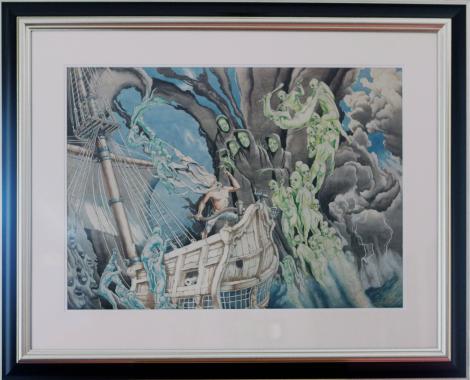Van Der Decken - The Flying Dutchman

Van der Decken (The Flying Dutchman)
Watercolour - Signed and dated 1935
Image Area: 21ins x 29ins - Framed: 34ins x 41.5ins
Suggested Offer £4,995
The most famous of all phantom vessels, supposedly seen in stormy weather off the Cape of Good Hope but now and then reported in other latitudes
The term 'Flying Dutchman' actually refers to the captain, not his ship. Legend has it that this maniacal Dutch sea captain was struggling to round the Cape of Good Hope in the teeth of a terrible gale that threatened to sink his ship and all aboard
The sailors warned him to turn around, the passengers pleaded, but the captain, refused to change course. Instead, he pressed on, singing loud and obscene songs, before going below to his cabin to drink beer and smoke his pipe
Monstrous waves pummelled the sides of the ship, howling winds bent the masts and tore at the sails, but still the captain held his course, challenging the wrath of God Almighty by swearing a blasphemous oath
Finally, there was a mutiny on board; the crew and passengers attempted to take control of the ship, but the captain, roused from his drunken stupor, killed the leader of the rebellion and threw him overboard. The moment the body hit the water, the clouds parted, and a shadowy figure materialized on the quarterdeck
"You're a very stubborn man," the shadow said, and the captain answered him with a cuss-word. "I never asked for a peaceful passage," the captain went on. "I never asked for your help”
But the figure didn't move. Drawing his pistol, the captain tried to fire, but the gun exploded in his hand. Now the figure spoke again, and told the captain he was accursed
"As a result of your actions you are condemned to sail the oceans for eternity with a ghostly crew of dead men, bringing death to all who sight your spectral ship, and to never make port or know a moment's peace," the shadow said, "Furthermore, gall shall be your drink, and red hot iron your meat" The captain, reckless to the last, cried, "Amen to that"
And so, for centuries from then on, the Flying Dutchman was seen piloting his spectral vessel, its canvas spread, its masts creaking in a fearful wind. Sometimes, it was said, he led other ships astray, onto rocky shoals and hidden reefs. Also he was said to be responsible for turning sailors' food supplies sour. His ship, looking innocent enough, would sometimes draw alongside another vessel and send letters aboard. But if the letters were opened and read, the ship would founder
Those who saw the captain himself claimed that he was bareheaded and repentant, clasping the wheel on the quarterdeck, pleading the heavens for mercy at last. In the rigging of his ship, some said they could see a crew of skeletons, grinning miserably as they put on ever more sail
This work is the companion to the Seven Deadly Sins. It took Norman nearly a year to complete these two most important works from his Allergoric period whilst at Birmingham College of Art. It would have been interesting to know what his tutors thought about this early work but we know that Norman didn't show them.
When Norman painted the 3 works including the Isle of Sirens and the Seven Deadly Sins, he was concerned what others (including his parents) would think was in his mind so the paintings remained hidden for many years until they were eventually sold to a private collector. They are reproduced here with kind permission of the owners
